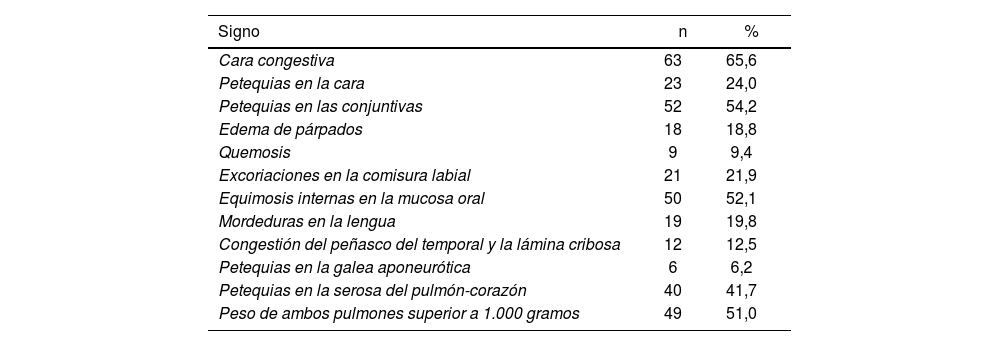el presente estudio describe las características de las víctimas de muertes por sofocación homicida con bolsas de plástico en el período comprendido entre 2008 y 2021, en necropsias practicadas en el Instituto Nacional de Medicina Legal y Ciencias Forenses de la ciudad de Medellín.
Materiales y métodosse realizó un estudio descriptivo, retrospectivo, cuya información se obtuvo a partir de los informes de necropsia realizados por médicos forenses de la institución.
Resultadosde las 38.772 necropsias realizadas, 17.703 fueron homicidios de las cuales 96 (0,54%) fueron debidas a la utilización de bolsas de plástico para producir la muerte. De los 96 casos analizados el 92,7% (89) correspondieron a hombres y el 7,3% (7) a mujeres. La población masculina joven de los 15 a 27 años fue la más afectada; el 74,4% (71) ingresaron como cadáveres no identificados y en el 17,1% (14) fue considerado el diagnóstico de tortura dentro del análisis de la necropsia médico legal.
Los hallazgos de sofocación en el examen externo fueron congestión facial 67,1% (55), petequias en las conjuntivas 63,4% (52), petequias en la cara 28,0% (23), lesiones en la mucosa oral interna 61,0% (50) y excoriaciones en las comisuras labiales 25,6% (21) por el uso de elementos extraños en la cavidad oral o la aplicación de maniobras asfícticas. El 58,5% (56) presentaban signos de trauma en otros sitios del cuerpo que no explicaban en sí la causa de la muerte. El 36,4% (35) presentaban bolsas de plástico cubriendo la cabeza y ajustadas al cuello con algún elemento, el 32,3% (31) cinta trasparente adherida a la bolsa plástica que cubría la cabeza y el 31,3% (30) presentaban una película plástica de nombre comercial Vinipel MR. El 76,8% (73) tenían las manos y los pies atados al momento del hallazgo del cuerpo en la escena.
Conclusióneste es el primer paso para obtener información de la caracterización de individuos y sus hallazgos macroscópicos relacionados con las muertes homicidas por sofocación con bolsas de plástico, alertar sobre actuación de grupos delincuenciales organizados y las prácticas de estos en el contexto transnacional. Sin embargo, su análisis requiere una adecuada exploración de la escena, los resultados que arrojen las investigaciones adelantadas por la autoridad y la realización de una necropsia exhaustiva para lograr su diagnóstico.
This study describes the characteristics of the victims of deaths by homicidal suffocation with plastic bags in the period between 2008 and 2021, in autopsies performed at the National Institute of Legal Medicine and Forensic Sciences of the city of Medellín.
Materials and methodsA descriptive, retrospective study was carried out, whose information was obtained from the autopsy reports made by forensic doctors of the institution.
ResultsOf the 38,772 autopsies performed, 17,703 were homicides, of which 96 (0.54%) were due to the use of plastic bags to produce death. Of the 96 cases analyzed, 92.7% (89) corresponded to men and 7.3% (7) to women. The young male population between the ages of 15 and 27 was the most affected; 74.4% (71) entered as unidentified corpses and in 17.1% (14) the diagnosis of torture was considered within the analysis of the legal medical necropsy.
The findings of suffocation in the external examination were facial congestion 67.1% (55), petechiae in the conjunctivae 63.4% (52), petechiae on the face 28.0% (23), lesions in the internal oral mucosa 61.0% (50), and abrasions in the labial commissures 25.6% (21) due to the use of foreign elements in the oral cavity or application of asphyctic maneuvers. 58.5% (56) presented signs of trauma in other parts of the body that did not explain the cause of death. 36.4% (35) had plastic bags covering the head and adjusted to the neck with some element, 32.3% (31) transparent tape attached to the plastic bag that covered the head and 31.3% (30) presented a plastic film with the trade name Vinipel MR. 76.8% (73) had their hands and feet tied when the body was found at the scene.
ConclusionThis is the first step to obtain information on the characterization of individuals and their macroscopic findings related to homicide deaths due to suffocation with plastic bags, to warn about the actions of organized criminal groups and their practices in the transnational context. However, its analysis requires an adequate exploration of the scene, the results of the investigations carried out by the authority and the performance of an exhaustive necropsy to achieve a diagnosis.









